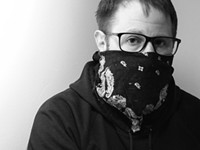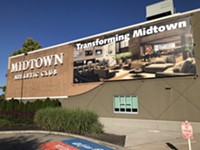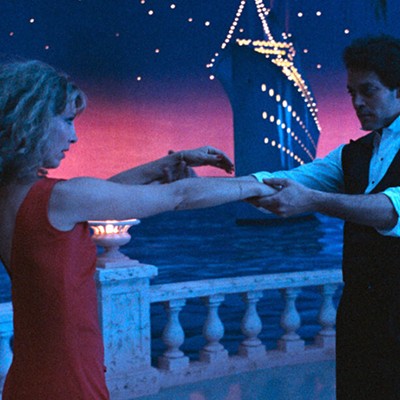[
{
"name": "500x250 Ad",
"insertPoint": "5",
"component": "15667920",
"parentWrapperClass": "",
"requiredCountToDisplay": "1"
}
]
Although there has been tension between science and religion since well before Darwin, passions are running higher than ever. The lines are drawn: you're either with God or you're against him. That is, you support teaching intelligent design or you "believe in" evolution, as if it's some half-cocked theory like, well, ID.
You're either a Christian or you should be, as President Bush hinted when he was in China, pretending to encourage greater religious freedom there. Much like how Vice President Cheney recently claimed to welcome debate on Iraq --- as long as it's supportive and it's not really debate --- the feeling today is that religion is okay as long as it's the right one.
On the other hand is the new Darwin exhibit at the AmericanMuseum of Natural History in NYC, which I haven't seen yet. Has it been mounted as a massive rebuke to the naysayers? I don't know, but it's already being pulled into the debate. One New York Times reviewer wonders why the show didn't acknowledge some of the changes and refinements made to the theory of evolution over time.
Are scientists in the bunker, afraid to reveal any discussions and disagreements? If so, it means times haven't changed much: Darwin sat on his theory for a decade before publishing it. When a scientist is afraid to go forward with his ideas, you know society needs a kick in the pants.
A little of that tension has always resided within me. The tension between science, which my family embraced, and organized religion, which made some kids cliquish and some adults belligerent. My parents had rejected their fire-and-brimstone Catholic church long before I came along. Though my father followed Eastern religions and practices, he did so alone. I was raised without religion.
That was fine with me. The '70s were a great time to be religion-free. It was the age of Rachel Carson and Small Planet cookbooks and the odd idea of separating your trash and taking it to a place called a recycling center, where someone else would make something new out of it in order to save the Earth. We didn't need a macho authority figure up there in the clouds. We had Mother Nature.
On our frequent hikes in New Hampshire and trips to seaside nature preserves in Massachusetts, my mother called our attention to the colors and smells, the animals and plants. Every skunk cabbage, poking its hardened, stinky beak up through early spring's frozen mud, was a miracle. Every beach rosehip, fat with bitter juice from which we made jam in the late summer, was a revelation.
All of these discoveries we enjoyed as miracles but discussed as science. I found beauty in the enjoyment and understanding of things. Nature was science. If there had to be a God, we agreed with Frank Lloyd Wright who said, "I believe in God, only I spell it Nature."
When, as a teen, I looked for answers, I found them in an unlikely place. An ugly and complex electromagnetic spectrum chart that my father had brought home from San Francisco's Exploratorium made its way onto my bedroom wall. I don't know exactly when it became central to my self-styled spiritual-scientific philosophy of life. To me, the electromagnetic spectrum was like a tree of life, or, rather, a tree of energy.
It described an invisible, omnipresent force; nearly everything I experienced lay somewhere along that spectrum. I loved that it could explain color and light, heat and tanning, X-rays and those black lights at Spencer Gifts. It was all there, if you looked hard enough. Sort of like the Bible, I guess.
The coolest waves were at the far edges of the spectrum. As a young anti-nuke activist, it confounded me that the power in those tiny gamma rays could be both beneficial and destructive. Way at the other end of the spectrum were the larger, car-sized FM radio waves that brought Aerosmith and Tom Petty into my bedroom. Late at night, with my ear pressed against a short-wave radio, I'd seek out foreign voices rolling toward me across the ocean.
But the invisible forces didn't stop there. Like the giant ears of a partially hidden deity, the satellite dishes dominating the New England landscape --- Cold War eavesdroppers --- were also represented on my chart. And if that symbolism wasn't quite enough, at the time my father's job was designing the software those radars used.
The tension between religion and science has always seemed like an either/or proposition. You couldn't have both. It wasn't until physicist Freeman Dyson won the top religious prize in 2000 that I found a way to reconcile the two. There's never been a better time than now to recall what he said:
"Science and religion are two windows that people look through, trying to understand the big Universe outside, trying to understand why we are here. The two windows give different views, but both look out at the same Universe. Both views are one-sided; neither is complete. Both leave out essential features of the real world. And both are worthy of respect."
I like the calm truce in this statement. A great mind should be able to embrace both science and religion. Now it is this quote, not the electromagnetic spectrum chart, that I tape up where ever I go --- over my desk and in my kitchen. That old chart finally fell apart a few years ago, and I tossed it. But, like a parent who feels guilty that she doesn't drag her children to church more often, I feel bad that my kids are growing up without an electromagnetic spectrum chart. I wonder how they explain the world to themselves.
Speaking of...
-
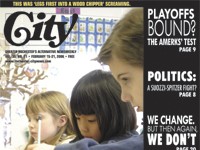
God, Grades, and the Gospel
Feb 15, 2006 -
Reader feedback - 11.23.05
Nov 23, 2005 -
Is ignorance bliss?
Nov 9, 2005 - More »
Latest in Columns
More by Jennifer Loviglio
-
The XX Files
Nov 15, 2006 -
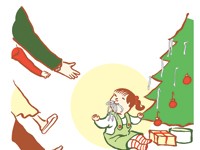
Silent (politically correct) night
Nov 15, 2006 -
Escape to Jennitopia
Nov 1, 2006 - More »

